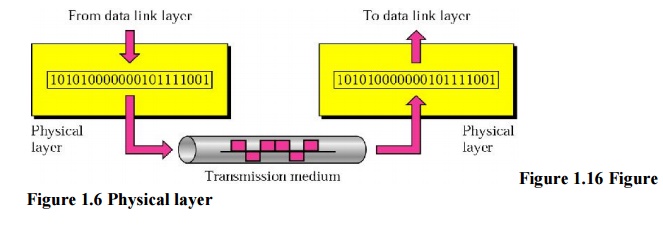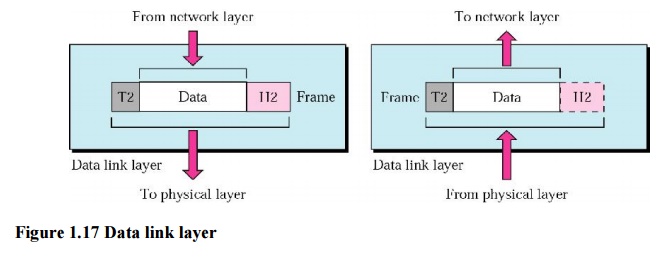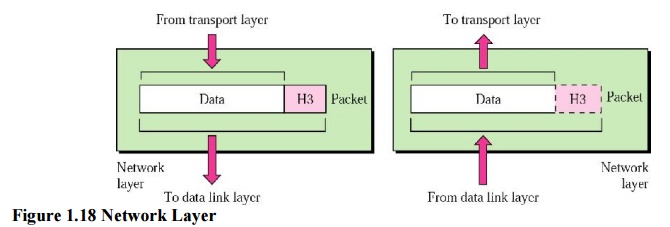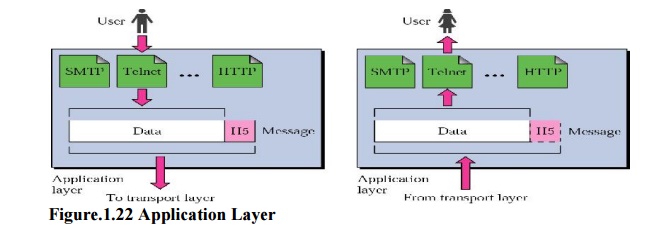Chapter: Computer Networks : Physical Layer
Layers in the OSI Model
Layers in the OSI Model:
The
functions of each layer in the OSI model are
1. Physical Layer
The
physical layer coordinates the functions required to carry a bit stream over a
physical medium. It deals with the mechanical and electrical specifications of
the interface and transmission medium.
The physical layer is responsible for movements of
individual bits from one hop (node) to the next.

The
physical layer is also concerned with the following:
a. Physical characteristics of interfaces and
medium. The physical layer defines thecharacteristics of the interface between
the devices and the transmission medium.
b. Representation of bits. The
physical layer data consists of a stream of bits (sequence ofOs or 1s) with no
interpretation.
c. Data rate. The transmission rate-the
number of bits sent each second-is also defined bythe physical layer.
d. Synchronization of bits. The
sender and receiver not only must use the same bit rate butalso must be
synchronized at the bit level.
e. Line configuration. The
physical layer is concerned with the connection of devices tothe media; it may
be point-to-point configuration or multi-point.
f. Physical topology. The
physical topology defines how devices are connected to make anetwork. Ex. Mesh,
Star, Ring, Bus, or a hybrid topology.
g. Transmission mode. The
physical layer also defines the direction of transmissionbetween two devices:
simplex, half-duplex, or full-duplex.
2. Data Link Layer
The data
link layer transforms the physical layer, a raw transmission facility, to a
reliable link. The data link layer is
responsible for moving frames from one hop (node) to the next.
Other
responsibilities of the data link layer include the following:
1. Framing. The data link layer divides the
stream of bits received from the network layerinto manageable data units called
frames.
2. Physical addressing. If
frames are to be distributed to different systems on the network,the data link
layer adds a header to the frame to define the sender and/or receiver of the
frame.

3. Flow control. If the rate at which the data
are absorbed by the receiver is less than therate at which data are produced in
the sender, the data link layer imposes a flow control mechanism to avoid
overwhelming the receiver.
4. Error control. The data link layer adds
reliability to the physical layer by addingmechanisms to detect and retransmit
damaged or lost frames.
5. Access control. When two or more devices are
connected to the same link, data linklayer protocols are necessary to determine
which device has control over the link at any given time.
3. Network Layer:
The
network layer is responsible for the source-to-destination delivery of a
packet, possibly across multiple networks (links). Figure 1.18 shows the
relationship of the network layer to the data link and transport layers.

The network layer is responsible for the delivery
of individual packets from the source host to the destination host.
Other
responsibilities of the network layer include the following:
1. Logical addressing. The network layer
adds a header to the packet coming from the upper layer that, among other
things, includes the logical addresses of the sender and receiver.
2. Routing. When independent networks or
links are connected to create intemetworks or a large network, the connecting
devices route or switch the packets to their final destination.
4. Transport layer:
The
transport layer is responsible for process-to-process delivery of the entire
message. A process is an application program running on a host. The transport
layer ensures that the whole message arrives intact and in order, overseeing
both error control and flow control at the source-to-destination level. Figure
1.19 shows the relationship of the transport layer to the network and session
layers.
The transport layer is responsible for the delivery
of a message from one process to another.

Other responsibilities
of the transport layer include the following:
a. Service-point addressing.
Source-to-destination delivery means delivery not only from one computer to the
next but also from a specific process (running program) on one computer to a
specific process (running program) on the other. The transport layer header
must therefore include a type of address called a service-point address (or
port address).
b. Segmentation and reassembly. A
message is divided into transmittable segments, with each segment containing a
sequence number. These numbers enable the transport layer to reassemble the
message correctly upon arriving at the destination and to identify and replace
packets that were lost in transmission.
c. Connection control. The
transport layer can be either connectionless or connection oriented. A
connectionless transport layer treats each segment as an independent packet and
delivers it to the transport layer at the destination machine. A connection
oriented transport layer makes a connection with the transport layer at the
destination machine first before delivering the packets. After all the data are
transferred, the connection is terminated.
d. Flow control. The transport layer is
responsible for flow control. However, flow control at this layer is performed
end to end rather than across a single link.
e. Error control. The transport layer is
responsible for error control. However, error control at this layer is performed
process-to-process rather than across a single link.
5. Session Layer:
The
session layer is the network dialog controller. It establishes, maintains, and
synchronizes the interaction among communicating systems.
The session layer is responsible for dialog control
and synchronization.

Specific responsibilities of the session layer include the following:
a. Dialog control. The session layer allows two
systems to enter into a dialog. It allows the communication between two
processes to take place in either half duplex or full-duplex.
b. Synchronization. The
session layer allows a process to add checkpoints, or synchronization points, to
a stream of data.
6. Presentation Layer:
The
presentation layer is concerned with the syntax and semantics of the
information exchanged between two systems.
The presentation layer is responsible for
translation, compression, and encryption.

Specific
responsibilities of the presentation layer include the following:
a. Translation. The processes (running
programs) in two systems are usually exchanging information in the form of character
strings, numbers, and so on. The information must be changed to bit streams
before being transmitted.
c. Encryption. A system must be able to ensure
privacy. Encryption means that the sender transforms the original information to
another form and sends the resulting message out over the network. Decryption
reverses the original process to transform the message back to its original
form.
d. Compression. Data compression reduces the
number of bits contained in the information. It is very important in the
transmission of multimedia such as text, audio, and video.
7. Application Layer:
The
application layer enables the user, whether human or software, to access the
network. It provides user interfaces and support for services such as
electronic mail, remote file access and transfer, shared database management,
and other types of distributed information services.
The application layer is responsible for providing
services to the user.
Specific
services provided by the application layer include the following:
a. Network virtual terminal. It is a
software version of a physical terminal, and it allows a user to log on to a
remote host. To do so, the application creates a software emulation of a
terminal at the remote host.
b. File transfer, access, and management. This
application allows a user to access files in a remote host, to retrieve files
from a remote computer for use in the local computer, and to manage or control
files in a remote computer locally.
c. Mail services. This application provides the
basis for e-mail forwarding and storage.
d. Directory services. This
application provides distributed database sources and access for global
information about various objects and services.

Related Topics